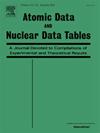Quantifying Webpage Performance: A Comparative Analysis of TCP/IP and QUIC Communication Protocols for Improved Efficiency
IF 2.7
3区 物理与天体物理
Q2 PHYSICS, ATOMIC, MOLECULAR & CHEMICAL
引用次数: 0
Abstract
Browsing is a prevalent activity on the World Wide Web, and users usually demonstrate significant expectations for expeditious information retrieval and seamless transactions. This article presents a comprehensive performance evaluation of the most frequently accessed webpages in recent years using Data Envelopment Analysis (DEA) adapted to the context (inverse DEA), comparing their performance under two distinct communication protocols: TCP/IP and QUIC. To assess performance disparities, parametric and non-parametric hypothesis tests are employed to investigate the appropriateness of each website’s communication protocols. We provide data on the inputs, outputs, and efficiency scores for 82 out of the world’s top 100 most-accessed websites, describing how experiments and analyses were conducted. The evaluation yields quantitative metrics pertaining to the technical efficiency of the websites and efficient benchmarks for best practices. Nine websites are considered efficient from the point of view of at least one of the communication protocols. Considering TCP/IP, about 80.5% of all units (66 webpages) need to reduce more than 50% of their page load time to be competitive, while this number is 28.05% (23 webpages), considering QUIC communication protocol. In addition, results suggest that TCP/IP protocol has an unfavorable effect on the overall distribution of inefficiencies.量化网页性能:TCP/IP和QUIC通信协议提高效率的比较分析
浏览是万维网上的一项普遍活动,用户通常对快速的信息检索和无缝的交易表现出极大的期望。本文使用数据包络分析(DEA)对近年来访问频率最高的网页进行了全面的性能评估,比较了它们在两种不同的通信协议下的性能:TCP/IP和QUIC。为了评估性能差异,参数和非参数假设检验被用来调查每个网站的通信协议的适当性。我们提供了全球访问量最高的100个网站中82个网站的输入、输出和效率得分的数据,描述了实验和分析是如何进行的。评估产生了与网站的技术效率和最佳实践的有效基准有关的定量指标。从至少一种通信协议的角度来看,9个网站被认为是有效的。考虑到TCP/IP,大约80.5%的单位(66个网页)需要减少50%以上的页面加载时间才能具有竞争力,而考虑到QUIC通信协议,这个数字是28.05%(23个网页)。此外,研究结果还表明,TCP/IP协议对低效率的总体分布有不利影响。
本文章由计算机程序翻译,如有差异,请以英文原文为准。
求助全文
约1分钟内获得全文
求助全文
来源期刊

Atomic Data and Nuclear Data Tables
物理-物理:核物理
CiteScore
4.50
自引率
11.10%
发文量
27
审稿时长
47 days
期刊介绍:
Atomic Data and Nuclear Data Tables presents compilations of experimental and theoretical information in atomic physics, nuclear physics, and closely related fields. The journal is devoted to the publication of tables and graphs of general usefulness to researchers in both basic and applied areas. Extensive ... click here for full Aims & Scope
Atomic Data and Nuclear Data Tables presents compilations of experimental and theoretical information in atomic physics, nuclear physics, and closely related fields. The journal is devoted to the publication of tables and graphs of general usefulness to researchers in both basic and applied areas. Extensive and comprehensive compilations of experimental and theoretical results are featured.
 求助内容:
求助内容: 应助结果提醒方式:
应助结果提醒方式:


